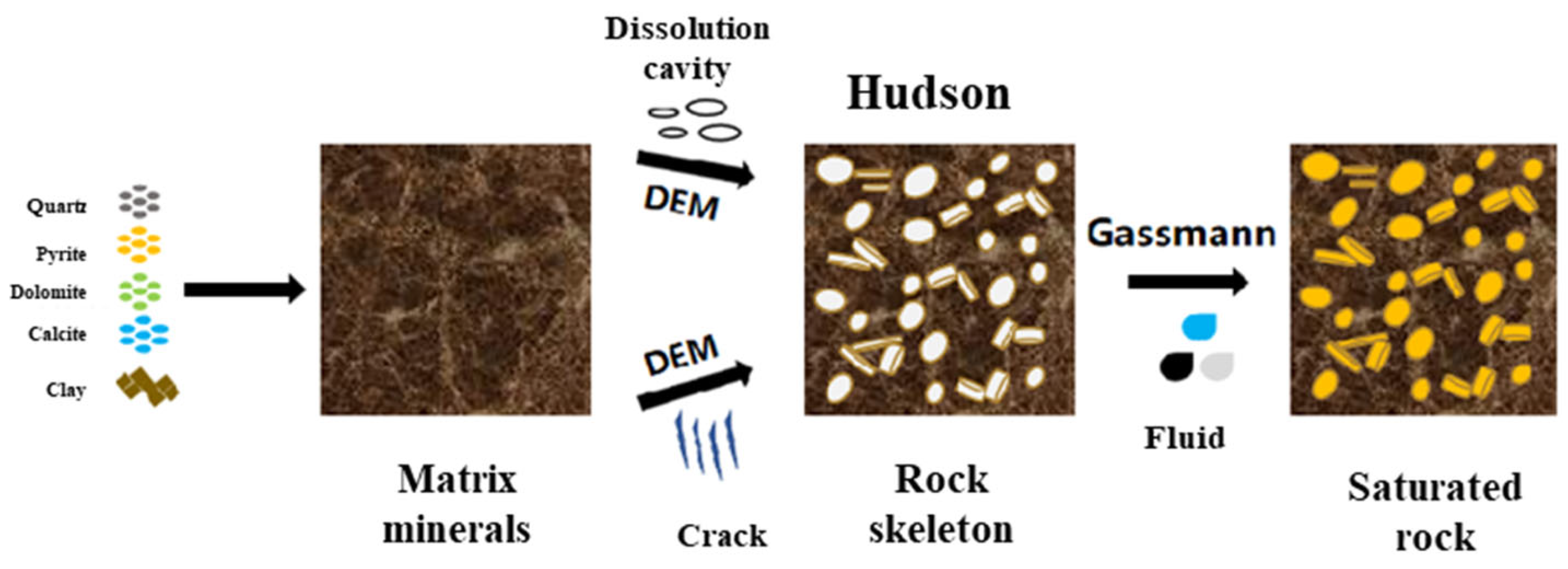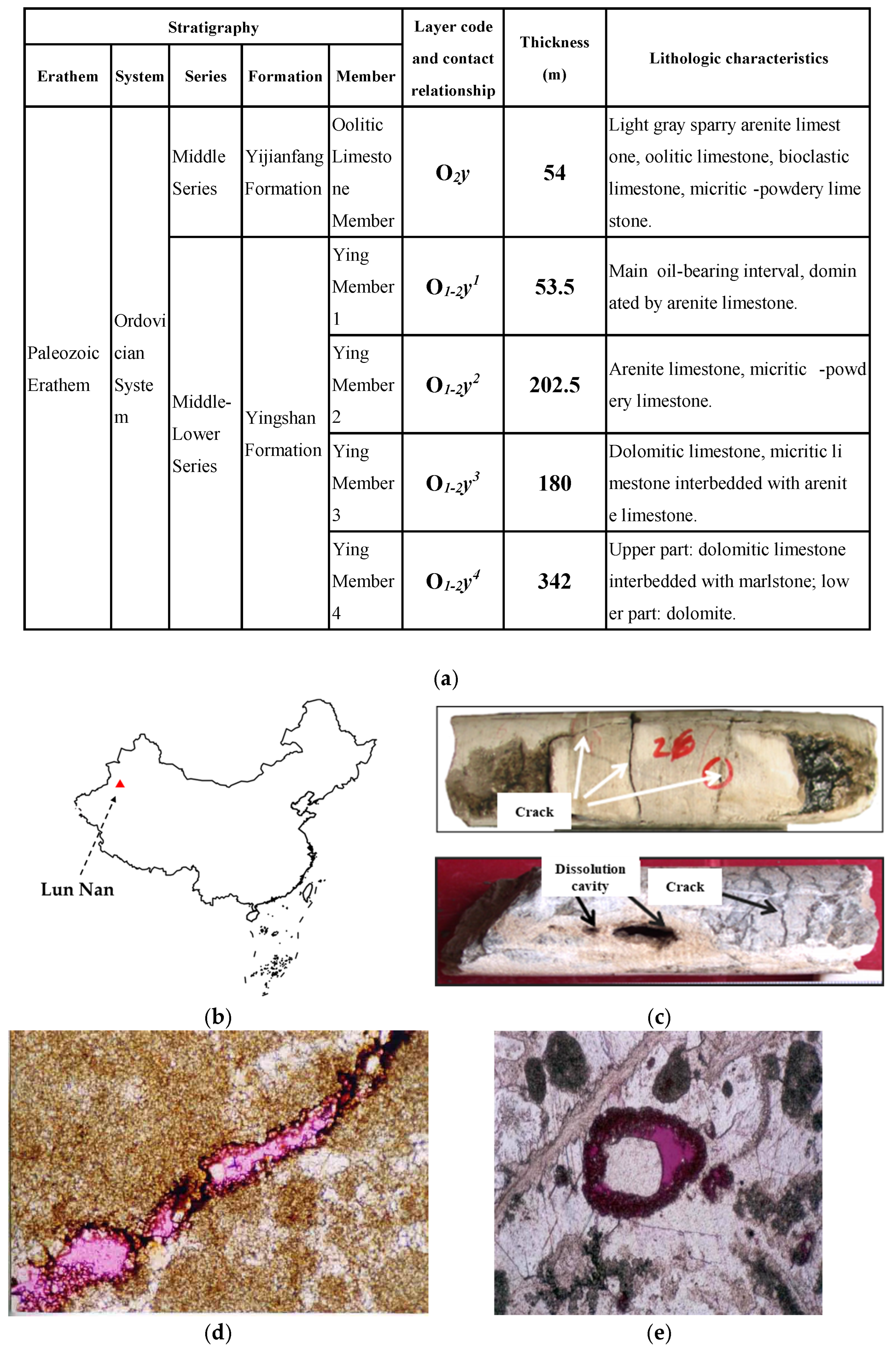Rock Physics Characteristics and Modeling of Deep Fracture–Cavity Carbonate Reservoirs
Abstract
1. Introduction
2. Basic Physical Characteristics of Reservoir Samples in Study Area
3. Rock Physics Modeling Methods
- (1)
- Calculating the mineral matrix modulus via VRH averaging.
- (2)
- Calculating the dry rock frame modulus via DEM theory.
- (3)
- Conducting fluid substitution using Wood’s equation and Gassmann’s theory.
- (4)
- Demonstrating fracture–cavity coupling via Hudson’s model.
- (1)
- The calculation of the matrix modulus of carbonate reservoirs.
- (2)
- The calculation of the skeletal modulus of dry rock in carbonate reservoirs.
- (3)
- The calculation of the modulus of fluid-saturated rocks [18].


3.1. Elastic Modulus of Rock Matrix
3.2. Modulus of Elasticity of Rock Skeletons
3.3. Modeling of Rock Anisotropy
3.4. Elastic Modulus Modeling for Fluid-Saturated Rocks
4. Results
5. Discussion
6. Conclusions
Author Contributions
Funding
Data Availability Statement
Acknowledgments
Conflicts of Interest
References
- Li, Y.; Kang, Z.; Xue, Z.; Zheng, S. Theories and practices of carbonate reservoirs development in China. Pet. Explor. Dev. 2018, 45, 712–722. [Google Scholar] [CrossRef]
- Bai, P.; Liu, D.; Suo, C.; Han, D.; Yang, L.; Song, L.; Yuan, Y.; Zhang, C. Research on integrated seismic geologie modeling of ultra-deepmarine carbonate reservoirs. Geophys. Prospect. Pet. 2024, 63, 1247–1258. [Google Scholar]
- Zhong, G. Study on Petrophysical Modeling for Fractured-Cavern Carbonate Reservoirs. Master’s Thesis, Yangtze University, Jingzhou, China, 2023. [Google Scholar]
- Wang, J.P.; Zhang, R.H.; Zhao, J.L.; Wang, K.; Wang, B.; Zeng, Q.L.; Liu, C. Characteristics and Evaluation of Fractures in Ultra-deep Tight Sandstone Reservoir: Taking Keshen Gasfield in Tarim Basin, NW China as an Example. Nat. Gas Geosci. 2014, 25, 1735–1745. [Google Scholar]
- Zhao, L.; Ma, J.; Li, K.; Zhu, J.; Gao, Z.; He, Z.; Geng, J. Seismic rock physics characteristics and modeling of ultra-deep carbonate reservoir. Chin. J. Geophys. 2023, 66, 16–33. [Google Scholar]
- He, Z.; Ma, Y.; Zhu, D.; Duan, T.; Geng, J.; Zhang, J.; Ding, Q.; Qian, Y.; Wo, Y.; Gao, Z. Theoretical and technological progress and research direction of deep and ultra-deep carbonate reservoirs. Oil Gas. Geol. 2021, 42, 533–546. [Google Scholar]
- Ma, Y.; Cai, X.; Yun, L.; Li, Z.; Li, H.; Deng, S.; Zhao, P. Practice and theoretical and technical progress in exploration and development of Shunbei ultra-deep carbonate oil and gas field, Tarim Basin, NW China. Pet. Explor. Dev. 2022, 49, 1–17. [Google Scholar] [CrossRef]
- Assefa, S.; McCann, C.; Sothcott, J. Velocities of compressional and shear waves in limestones. Geophys. Prospect. 2003, 51, 1–13. [Google Scholar] [CrossRef]
- François, F.; Matthieu, P.; Quentin, V.; Thomas, T.; Fei, H.; Emmanuelle, P.; Jean, B.; Philippe, L.; Alex, H. The equivalent pore aspect ratio as a tool for pore type prediction in carbonate reservoirs. Aapg. Bull. 2018, 102, 1343–1377. [Google Scholar]
- Teillet, T.; Fournier, F.; Zhao, L.; Borgomano, J.; Hong, F. Geophysical pore type inversion in carbonate reservoir: Integration of cores, well logs, and seismic data (Yadana field, offshore Myanmar). Geophysics 2021, 86, B149–B164. [Google Scholar] [CrossRef]
- Keys, R.G.; Xu, S. An approximation for the Xu-White velocity model. Geophysics 2002, 67, 1406–1414. [Google Scholar] [CrossRef]
- Xu, S.; Payne, M.A. Modeling elastic properties in carbonate rocks. Lead. Edge. 2009, 28, 66–74. [Google Scholar] [CrossRef]
- Zhang, B.; Liu, Z.; Liu, J.; Xia, H.; She, X.; Wang, J.; Liu, L. An improved S-wave velocity prediction method for complex carbonate reservoir in North Ordos Basin, China. Geophys. Prospect. Pet. 2017, 56, 328–337. [Google Scholar]
- Sun, S.Z.; Wang, H.; Liu, Z.; Li, Y.; Zhou, X.; Wang, Z. The theory and application of DEM-Gassmann rock physics model for complex carbonate reservoirs. Lead. Edge. 2012, 31, 152–158. [Google Scholar] [CrossRef]
- Zhao, L.; Nasser, M.; Han, D.H. Quantitative geophysical pore-type characterization and its geological implication in carbonate reservoirs. Geophys. Prospect. 2013, 61, 827–841. [Google Scholar] [CrossRef]
- Li, X.; Wei, W.; Wang, L.; Cai, J. Fractal Dimension of Digital 3D Rock Models with Different Pore Structures. Energies 2022, 15, 7461. [Google Scholar] [CrossRef]
- Tan, K.J.; Zhao, J.G.; Teng, T.Y.; Liu, X.Z.; Yan, B.H. Research on effectiveness of effective pore aspect ratio based on pore-throat characteristics of digital core. Chin. J. Geophys. 2022, 65, 4433–4447. (In Chinese) [Google Scholar]
- Li, H.; Zhang, J.; Cai, S.; Pan, H. 3D rock physics template for reservoirs with complex pore structure. Chin. J. Geophys. 2019, 62, 2711–2723. (In Chinese) [Google Scholar]
- Mavko, G.; Mukerji, T.; Dvorkin, J. The Rock Physics Handbook: Tools for Seismic Analysis of Porous Media; Cambridge University Press: Cambridge, UK, 2003. [Google Scholar]
- Hudson, J.A. Wave speeds and attenuation of elastic waves in material containing cracks. Geophys. J. Int. 1981, 64, 133–150. [Google Scholar] [CrossRef]
- Wang, X.Q.; Schubnel, A.; Fortin, J.; David, E.C.; Guéguen, Y.; Ge, H.K. High Vp/Vs ratio: Saturated cracks or anisotropy effects? Geophys. Res. Lett. 2012, 39, L11307-1–L11307-6. [Google Scholar] [CrossRef]
- Zhang, X.A.; Wang, Z.; Yang, Z. Distinguishing oil and water layers in a porous cracked medium by interpreting acoustic logging data on the basis of Hudson Theory. J. Earth Sci. 2017, 28, 500–506. [Google Scholar] [CrossRef]
- Alireza, S.; Mike, M.; Lori, H. Multi-physics rock templates to seismically characterise complex carbonates. Explor. Geophys. 2022, 53, 547–562. [Google Scholar]
- Zhang, J.; Wang, X.; Xiao, H.; Ge, H.; He, J. Study on Fracture Propagation Rules of Shale Refracturing Based on CT Technology. Processes 2024, 12, 131. [Google Scholar] [CrossRef]
- Corrêa, S.N.; Bezerra, F.H.R.; La Bruna, V.; Ida, M.; Stohler, R.C.; Moriss, M.A.G.; Dantas, T.B.; Bagni, F.L.; Araújo, R.E.B.; Roisenberg, C.; et al. 3D geological modeling and reservoir production numerical simulation of multiple scenarios in fractured-karstified carbonate reservoirs using high-resolution outcrop characterization. Geoenergy Sci. Eng. 2025, 251, 213866. [Google Scholar] [CrossRef]
- Gumati, M.S. Fluid and lithology discrimination using integrated facies, petrophysical modelling and (AI and vp/vs) rock physics template analysis derived from well data in the carbonate fault-controlled reservoir: A case study from the North Beda Field, Amin High, Sirt Basin, Libya. Acta Geophys. 2024, 73, 1–22. [Google Scholar]
- Li, B.; He, Y.; Chen, W.; Shang, H.; Wang, L. Geological modeling of carbonate fracture-cavity reservoir: Case Study of Shunbei Fault Zone No. 5. Front. Earth Sci. 2025, 13, 1559030. [Google Scholar] [CrossRef]
- Mirshadi, A.; Javaherian, A.; Khoshdel, H.; Saberi, M.R.; Kadkhodaie, A. Identification of the bound and free fluid pore types in an Iranian carbonate reservoir through the integration of well logs, rock physics modeling, and 3D seismic data. J. Pet. Explor. Prod. Technol. 2025, 15, 108. [Google Scholar] [CrossRef]
- Cataldo, R.A.; Leite, E.P. Integrated machine learning workflow for 3D pore type modeling in the pre-salt carbonates of the Tupi Field, Santos Basin. J. Appl. Geophys. 2025, 237, 105689. [Google Scholar] [CrossRef]
- Słonka, A.; Krajewski, M.; Krzywiec, P. Internal structure of the Upper Jurassic subsurface carbonate buildups of the northern Tethys shelf in southern Poland—Integration of Seismic Forward Modeling and Outcrop Analogs. Mar. Pet. Geol. 2025, 177, 107367. [Google Scholar] [CrossRef]
- Vescogni, A.; Colombo, F.; Guido, A. New Insights Into Upper Messinian Microbial Carbonates: A Dendrolite-Thrombolite Build-Up from the Salento Peninsula, Central Mediterranean. Geobiology 2025, 23, e70023. [Google Scholar] [CrossRef]
- Ali, T.U.H.; Ahmad, S.; Ahmad, S.; Siyar, S.M.; Rehman, G.; Irfan, M.; Kontakiotis, G.; Ahmed, M.S.; Fathy, D. Subsurface Structural Framework, Fault Modeling, and Petrophysical Analysis of Paleogene Carbonates in the Rajian Oilfield, Potwar Basin, Pakistan. Dokl. Earth Sci. 2025, 521, 12. [Google Scholar] [CrossRef]
- Behdad, A.; Cuddy, S. Water saturation modeling in carbonate reservoirs using the bulk volume water approach. J. Pet. Explor. Prod. Technol. 2025, 15, 105. [Google Scholar] [CrossRef]
- Huang, C.; Zhu, X.; Lu, M.; Zhang, Y.; Yang, S. XGBoost algorithm optimized by simulated annealing genetic algrithm for permeability prediction modeling of carbonate reservoirs. Sci. Rep. 2025, 15, 14882. [Google Scholar] [CrossRef]








| Average Depth | Average Porosity | Average Permeability | Average Density | Main Mineral Content (%) | |||
|---|---|---|---|---|---|---|---|
| Calcite | Dolomite | Quartz | Clay | ||||
| 7200 m | 1.6% | 4.82 mD | 2.68 g·cm−3 | 96.66 | 1.58 | 1.18 | 0.58 |
Disclaimer/Publisher’s Note: The statements, opinions and data contained in all publications are solely those of the individual author(s) and contributor(s) and not of MDPI and/or the editor(s). MDPI and/or the editor(s) disclaim responsibility for any injury to people or property resulting from any ideas, methods, instructions or products referred to in the content. |
© 2025 by the authors. Licensee MDPI, Basel, Switzerland. This article is an open access article distributed under the terms and conditions of the Creative Commons Attribution (CC BY) license (https://creativecommons.org/licenses/by/4.0/).
Share and Cite
Fang, Q.; Ge, J.; Wang, X.; Zhou, J.; Li, H.; Zhao, Y.; Teng, T.; Yan, G.; Wang, M. Rock Physics Characteristics and Modeling of Deep Fracture–Cavity Carbonate Reservoirs. Energies 2025, 18, 3710. https://doi.org/10.3390/en18143710
Fang Q, Ge J, Wang X, Zhou J, Li H, Zhao Y, Teng T, Yan G, Wang M. Rock Physics Characteristics and Modeling of Deep Fracture–Cavity Carbonate Reservoirs. Energies. 2025; 18(14):3710. https://doi.org/10.3390/en18143710
Chicago/Turabian StyleFang, Qifei, Juntao Ge, Xiaoqiong Wang, Junfeng Zhou, Huizhen Li, Yuhao Zhao, Tuanyu Teng, Guoliang Yan, and Mengen Wang. 2025. "Rock Physics Characteristics and Modeling of Deep Fracture–Cavity Carbonate Reservoirs" Energies 18, no. 14: 3710. https://doi.org/10.3390/en18143710
APA StyleFang, Q., Ge, J., Wang, X., Zhou, J., Li, H., Zhao, Y., Teng, T., Yan, G., & Wang, M. (2025). Rock Physics Characteristics and Modeling of Deep Fracture–Cavity Carbonate Reservoirs. Energies, 18(14), 3710. https://doi.org/10.3390/en18143710






